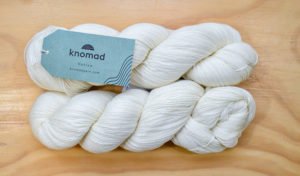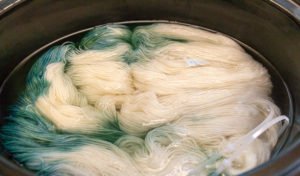Three Color Immersion Blend on VOTIVE
Votive is a soft, fingering weight yarn of 80% superwash merino, 10% cashmere, and 10% recycled nylon. This blend creates a yarn that is both light and strong. Today we will be dyeing up a three-color immersion blend on Votive using shades of green and teal! Immersion blends are a fun way to create multicolored skeins of yarn, similar to hand painting, but within your dye pot. The colors pool in the dye pot, creating pockets of color and blending beautifully with the other dyes. Let’s get started!
SUPPLIES
- Two skeins of VOTIVE
- Dharma Acid Dye in Teal Green, Sage Leaf, and Forest Green
- Citric Acid
- Slow cooker or steel pot with lid + heat source
- Tongs
- 3 Jars
- Tape and permanent marker
- 1/4 teaspoon
- Tongs or chopsticks
- Zip ties
- Gloves
- Apron
- Respirator mask
- Large bowl
- Water
- White utensil or dish (optional)
- *Any materials used in acid dyeing are no longer food safe and should be kept separate
PRESOAK
Loop a zip tie through each skein. The zip tie helps keep the yarn from tangling in the dye bath. Fill a large bowl with cool water and dissolve a tablespoon of citric acid. Submerge the two skeins of VOTIVE in the water and citric acid mixture.
Allow the yarn to become fully saturated. The yarn should darken by about two shades and be even in color throughout. This step is crucial for an even dye application as the wool yarn has a protective outer cuticle layer that needs to swell and open for the dye to penetrate the fibre’s core. A good presoak usually takes about an hour.
PREPARE THE DYE
Label each jar with the corresponding dye colors: Teal Green, Sage Leaf, and Forest Green. Fill each jar with one cup of the hottest water from your tap. Put on your respirator, gloves, and apron before dealing with powdered dyes. Dissolve ¼ teaspoon of the corresponding dye pigment into each jar. Add a dash of citric acid to each dye jar. I used less than a tablespoon for all three jars. Set these jars aside for now.
ADD THE YARN AND HEAT
Add the presoaked yarn to your dye pot and enough soaking liquid to barely cover the yarn. You want less than an inch of water above the yarn. Turn the heat to medium-high and cover the yarn and dye pot with a lid. Allow the yarn to preheat for at least 30 minutes.
ADD THE DYE
Once the yarn has preheated, it is time to add the dye! Pour the Sage Leaf dye solution over one-third of the yarn. Use tongs or chopsticks to work the dye throughout this section. Lift the yarn in this area to allow the dye to flow to the bottom of the pot.
Next, pour the Teal Green dye solution over the opposite third. This should leave an undyed section in the middle. Once again, use tongs or chopsticks to work the Teal Green dye throughout this section.
Finally, pour the Forest Green dye solution over the middle third of the yarn and work it throughout this section using tongs. Replace the lid and allow the yarn to heat set for at least 30 minutes. Once the dye bath is exhausted, turn off the heat and allow the yarn to cool. A dye bath is exhausted when no dye remains in the water. You can check for this by submerging a white spoon or cup into the water to check and see if the water is clear. When the water is clear, all the available pigment has been absorbed, and the yarn has finished dyeing.
COOL, RINSE, AND DRY
Turn off the heat and allow the yarn to cool fully before rinsing it. Rinse the yarn under cool, running water until the water runs clear. Squeeze out the excess water and rinse it once more. Then, hang the yarn to dry.
THE FINISHED YARN
This yarn reminds me of a flowing river or the blues and greens of a rainy, mossy winter in Portland, OR, where I live. Dyeing the yarn while the water is hot allows the color to strike quickly, creating more saturated sections and leaving some areas white. If you want a softer blend, add the dye while the water is cool, and then heat it up. This will create more subtle color blends and saturate more of the yarn.
Don’t forget to tag us on social media using @knomad_yarn and #knomadyarn. We can’t wait to see what you make!
[insert finished yarn2.jpg]


















